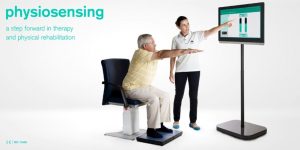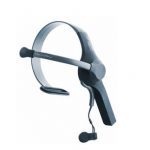“With PhysioSensing you will be able to evaluate the balance in several planes, promote load transfer exercises, evaluate the natural load distribution and perform a high number of therapeutic exercises. In addition to all these features you can also evaluate the plantar pressure by its 1600 sensors distributed in a 40 x 40 cm area,” notes Pedro De Jesus Mendes, one of the founders of Sensing Future Technologies.
Physiotherapy and Physical Rehabilitation uses a variety of techniques to help your muscles and joints work to improving, maintaining or restoring physical strength, cognition and mobility with maximized results. And also helps people gain greater independence after illness, injury or surgery. Physiotherapy helps with back pain or sudden injury, managing long-term medical condition such as asthma, and in preparing for childbirth or a sporting event.
Rehabilitation is the process of restoring and regaining physical strength and function and includes various therapies to help a person restore function after illness or injury. It describes specialized healthcare dedicated to improving, maintaining or restoring physical strength, cognition and mobility with maximized results. Typically, rehabilitation helps people gain greater independence after illness, injury or surgery.
Industry insight
The market for physiotherapy services is expected to increase at a significant growth rate owing to rising geriatric population across the world. Elderly people usually suffer from various ailments such as arthritis, cardiovascular diseases and chronic pain. Hence, they accentuate the demand for availing physiotherapy services to relax their body from the ailments. Elderly people are also raising the demand for palliative care that is provided via physiotherapy.
The World Health Organization has projected that by 2050, global geriatric population will reach a count of nearly 2 billion, which was around 547 million in 2010. Similarly, increasing incidences of orthopaedic disorders will further accentuate the growth of physiotherapy services market. Likewise, increasing women’s healthcare concern will also augment the growth of physiotherapy services market. Pregnant women require special physiotherapy services for maintaining their foetus growth and their health.
Hence, all the aforementioned factors will boost the growth of physiotherapy services market. The major players operating in physiotherapy services market include AmeriCare Physical Therapy, Meier & Marsh Physical Therapy, Rehab Alternatives, FullMotion Physical Therapy, Elam Sports Oahu and Minsu’s Healing Oasis amongst other significant players.
The global rehabilitation equipment and devices market size was valued at USD 10.53 billion in 2016 and is expected to grow at a CAGR of 6.0 per cent during the forecast period. The market is expected to witness significant growth owing to increasing prevalence of degenerative diseases, such as Parkinson’s, Alzheimer’s, & arthritis, and growing number of trauma patients who require rehabilitation therapy. Moreover, growing geriatric population is also expected to propel the market over the forecast period.
The need for daily assistive devices for handicapped population around the globe is increasing rapidly. Awareness about new products available in the market is also growing owing to new channels of communication that are being adopted by manufacturers. Thus, patients remain informed about upcoming products in the market. Local governments in several countries have provided easy financing, subsidies, and alternative financing options for rehabilitation equipment, which are expected to boost demand for assistive products & in turn lead to growth.
PhysioSensing
Sensing Future Technologies, a startup company based in Portugal, has developed a system called PhysioSensing that relies on a dense electronic pressure pad to assess a variety of characteristics about a person’s physical state,  including balance, limits of stability, and related parameters. It can also be used, in a combination with gaming software, to help people with neurological and musculoskeletal conditions to rehabilitate. MediWorld ME got a chance to speak with one of the company founders, Pedro De Jesus Mendes to tell us how about how PhysioSensing can help patients and specialists at a same time.
including balance, limits of stability, and related parameters. It can also be used, in a combination with gaming software, to help people with neurological and musculoskeletal conditions to rehabilitate. MediWorld ME got a chance to speak with one of the company founders, Pedro De Jesus Mendes to tell us how about how PhysioSensing can help patients and specialists at a same time.
PhysioSensing is a portable balance & pressure platform with visual biofeedback technology. It is part of a new generation of products for physical rehabilitation. “With PhysioSensing you will be able to evaluate the balance in several planes, promote load transfer exercises, evaluate the natural load distribution and perform a high number of therapeutic exercises. In addition to all these features you can also evaluate the plantar pressure by its 1600 sensors distributed in a 40 x 40 cm area,” remarks Mendes.
PhysioSensing is indicated for physiotherapy and physical rehabilitation activities, especially in the early rehabilitation of stroke and neuromusculoskeletal conditions of the lower limbs. A motivated patient recovers better, so he or she can make use of customized 2D or 3D therapeutic games based on balance and load transfer. Using equipment from this new generation of products allows you to evaluate your clinical practice and make it objective and quantified in a clinical report.
Assessment and capabilities
Maintaining fitness is essential throughout life. Our body was not made to stand still. A proactive lifestyle allows for two essential things: emotional well being and effective prevention of chronic diseases. The application of PhysioSensing refers to some specific clinical conditions. According to Mendes, the main focus of PhysioSensing is on the evaluation and training of Balance and they want to be a reference in this niche.
The PhysioSensing consists of a 40 x 40 cm array of sensors, making a total of 1,600 resistive sensors. Because it is resistive, the sensor varies its resistance according to the pressure exerted when we come in contact with the surface. By multiplying the pressure across the area of each sensor we can know the magnitude of the normal force per sensor.
“People with neurological and musculoskeletal conditions have changes in the balance and distribution of their weight in the lower limbs. PhysioSensing is a device that allows you to objectively quantify the balance and then trains you with training programs to improve it. The visual biofeedback in this process becomes very important since it is a motivating and stimulating element for the patient.
“Balance training programs have results with proven scientific evidence however if we think that people are 15 or 20 minutes always doing those programs they get bored. So the use of games allows doing the same therapeutic approach but using a game. Through the game the user is more committed to the training. It is a great way to make the patient proactively adhere to your therapy,” Mendes adds.
Pressure of Center (COP)
PhysioSensing is not a rehabilitation program. It is a device, a pressure platform with visual biofeedback. In the PhysioSensing are integrated protocols of evaluation and intervention software. Balance can be defined as the maintenance of the Pressure of Center (COP) within the support base. Already the processes that lead to the maintenance of balance require the complex coordination and integration of multiple ‘sensors’ of the human body: vestibular, vision and musculoskeletal.
“Thus, the body stability implies an effective and efficient organization of all intervening system actions. The stability conservation is a dynamic and continuous process commanded by the central nervous system that generates the patterns of muscular activity necessary to regulate the relationship between the center of gravity and the support base, establishing the balance between stabilization and destabilization forces”.
PhysioSensing requires the patient to train command patterns generated by the central nervous system by maintaining the position of the COP.
Complication coverage
PhysioSensing, in fact covers all complications that affect the balance. These complications may originate from:
– Neurological (e.g., stroke, Parkinson)
– Musculoskeletal (Knee, ankle or hip injury)
– Vestibular Dysfunctions
– Fall Risk in the Elderly
“In the development of PhysioSensing we always work with health professionals. However, we never ignore the state of scientific art. We have carefully studied a large number of scientific evidence about the benefits, difficulties and results of applying this type of technology”.
At the moment, the number of scientific papers documenting the use of these technologies is very high and references are easily found for:
- Balance training after stroke
- Balance training after head injury
- Assessment and reduction of risk of fall
- Load Distribution Training After Hip Surgery
- Balance training and load distribution after trauma to the knee and ankle
- Balance training for Cerebral Palsy and Parkinson’s
- Balance training for increased sports performance and reduced risk of injury
- Evaluation of vestibular balance
The team closely follows their clients to observe usage routines; document results obtained and conduct case studies or scientific articles.
From the perspective of the patient, PhysioSensing can be used to:
- Set goals to achieve
- Motivation to adhere to therapy
- Proactivity
- Effort quantify
From the perspective of the health professional, PhysioSensing can be used for:
- Quick assessment
- Therapeutic exercise
- Quantify results
- Evaluate the results of your therapeutic plan
- A focused niche
In the field of physical rehabilitation a new generation of products are emerging with more and more expression. This generation is characterized by measuring devices based on force sensors, inertial sensors / accelero-meters or motion sensors. These contribute to an objective and quantified assessment of the condition of the user. Information collected by all these sensors is condensed into a powerful visual biofeedback for the patient and health professional. The diversity of these devices is felt already and not everyone is prepared to reach the market. We have noticed that some devices are not yet oriented to the clinical practice of potential users.
The capabilities of PhysioSensing are grouped into small modules or categories:
- Evaluation and Training of Balance and Stability
- Load Distribution Assessment
- Load Transfer Training
- Feet Pressure Map
Protocols: Falling Risk, Limits of Stability-LOS, Modified Clinical Test f Sensory Interaction on Balance – CTSIB
One 2D game with several therapeutic situations
One 3D game with several therapeutic situations
“With PhysioSensing comes all stabilometric balance software: evaluation, training and therapeutic games. You can buy apart an advanced and specialized baropodometry module that is not developed by us. Our stabiliometric software only works on PhysioSensing. PhysioSensing is available in the market for purchase (www.physiosensing.net) and we ship worldwide. We are looking for distributors for PhysioSensing around the world and of course in the Middle East and the UAE.”
















